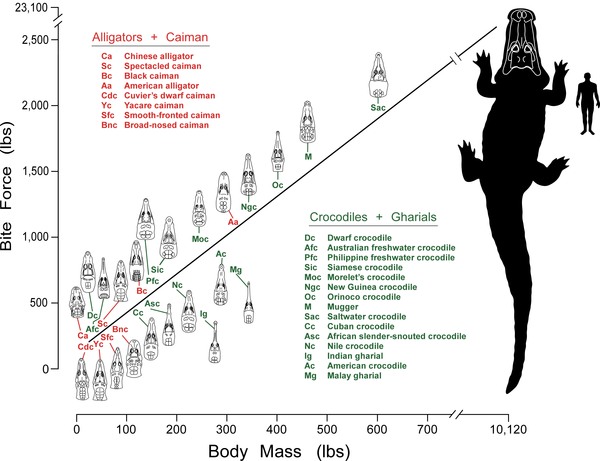|
|
Post by Godzillasaurus on Oct 20, 2013 18:47:20 GMT 5
news.nationalgeographic.com/news/2002/04/0404_020408_supercrocbite.htmlA lot of people may believe that sarcosuchus had weak jaws because it was "gharial-like". This is not true. Its jaws were actually very powerful and were not thin at all. Using modern crocodilians, its bite has been estimated at around 18,000 pounds psi, roughly 9 tons. Unfortunately, this appears to be rather inaccurate. The bite force of deinosuchus has been estimated at a staggering 23,000 pounds psi, despite it being a smaller animal.  Esimates of its bite force may be inconsistent, but it surely had powerful jaws nonetheless. By the way, I do realize that this article was written in 2003. It still proves that sarcosuchus was not a weak animal.
|
|
|
|
Post by creature386 on Oct 20, 2013 19:56:18 GMT 5
|
|
|
|
Post by theropod on Oct 20, 2013 20:38:22 GMT 5
Jaw shape seems to have relatively little impact on bite force in crocodilians, so Sarcosuchus very likely had a tremendously powerful bite. This is not necessarily correlated with how strong it's jaws were compared to other crocodilomorphs.
I think its jaw shape is somewhat reminiscent of Mecistops cataphractus.
What I find quite interesting is that there's a linear relationship between bite force and body weight. There must be strong positive allometry in their muscle size...
|
|
|
|
Post by Godzillasaurus on Oct 20, 2013 21:13:45 GMT 5
He was? I don't quite remember that. And I will fix that. I didn't know that pounds per square inch was so much different than just regular pounds. I honestly thought psi was just a fancy way of saying it  True, unless you are talking about gavialidae. How so? Sarcosuchus had much broader jaws that did not taper off into a point:  This is evidence that it was more of a generalist predator |
|
|
|
Post by creature386 on Oct 20, 2013 21:37:15 GMT 5
When Spinodontosaurus said it's jaws were weak on CF, he was referring to bending resistance, not bite force. He was? I don't quite remember that. Here the relevant quote:Given that he is a member here as well, you could continue the debate here (although spinodontosaurus is mostly inactive). However, it looks like the "slender snouted" argument is invalid now (but I will wait for his opinion, before I draw conclusions). |
|
|
|
Post by Godzillasaurus on Oct 22, 2013 23:02:48 GMT 5
And is there any real proof of little resistance to bending in sarcosuchus? Its jaws were not actually very slender, and did not resemble those belonging to gharials the least bit. Sarcosuchus did not have the morphology of a primarily piscivorous animal, which is why it is unlikely that its jaws were wean in the bending department. Oh yea, and its teeth did not interlock, which is yet another clue that it hunted larger animals.
|
|
|
|
Post by theropod on Oct 22, 2013 23:54:13 GMT 5
The jaws bear strong resemblance to the slender-snouted crocodile, Mecistops caraphractus. That's enough evidence it is also functionally somewhat similar.
Besides, most crocodilians are primarily piscivorous, this does not preclude predation upon larger animals.
|
|
|
|
Post by Godzillasaurus on Oct 23, 2013 0:55:48 GMT 5
I really wouldn't consider their similarities with the slender shouted crocodile to be THAT vivid. Sarcosuchus had jaws that really weren't pointy at all (at least in mature animals); they were tipped with a bulla, which was basically the bulbous part at the premaxilla of the top jaw. Spinosaurus, although irrelevant in this topic, had jaws that were much more reminiscent of extant slender-shouted crocodilians, as it's jaws were very thin (for theropod standards of course. They were still be strong), its teeth were less robust than sarcosuchus (designed less-so for crushing and rather for piercing deeply), and they interlocked. All of these features suggest that spinosaurus predated on large fish and was very week adapted for gripping resistance.
|
|
|
|
Post by theropod on Oct 23, 2013 18:29:51 GMT 5
Spinosaurus has little resemblence to Mecistops, the similarities to any extant crocodilian are superficial at best. It has fewer, less regular-sized teeth, some very large, it has a diastema in the toothrow, and a deeper but much narrower snout. The overall robusticity best compares to Tomistoma, but their jaws are not the same. Sarcosuchus' jaws resemble that of a large robust slender-snouted crocodile ( like the one here?), dorsoventrally a bit more flattened and laterally more expanded, with a more prominent spoon-shaped jaw tip. |
|
|
|
Post by Godzillasaurus on Oct 24, 2013 5:23:40 GMT 5
Spinosaurus has little resemblence to Mecistops, the similarities to any extant crocodilian are superficial at best. It has fewer, less regular-sized teeth, some very large, it has a diastema in the toothrow, and a deeper but much narrower snout. The overall robusticity best compares to Tomistoma, but their jaws are not the same. Sarcosuchus' jaws resemble that of a large robust slender-snouted crocodile ( like the one here?), dorsoventrally a bit more flattened and laterally more expanded, with a more prominent spoon-shaped jaw tip. You are correct there, but we were fundamentally talking about dorsal jaw shape in the first place. In that case, the similarities with Tomistoma or Mecistops (and the freshwater crocodile) would only be subtle. |
|
|
|
Post by theropod on Oct 24, 2013 15:50:33 GMT 5
The general shape is similar, especially to Mecistops. Sarcosuchus can have somewhat wider jaws, that seems to be an allometry common in crocodylomorphs, but it doesn´t change the basic similarity.
In any case it is much more similar to Mecistops than to Crocodylus.
|
|